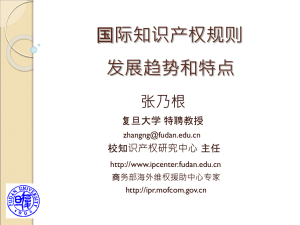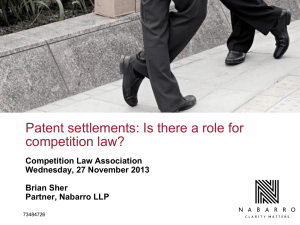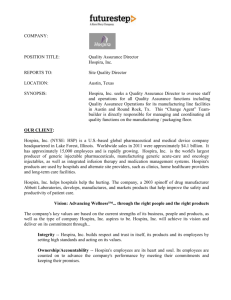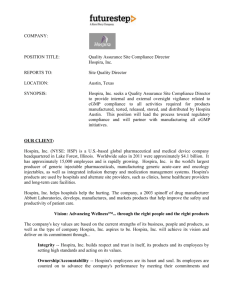Patent linkage and the TPP
advertisement
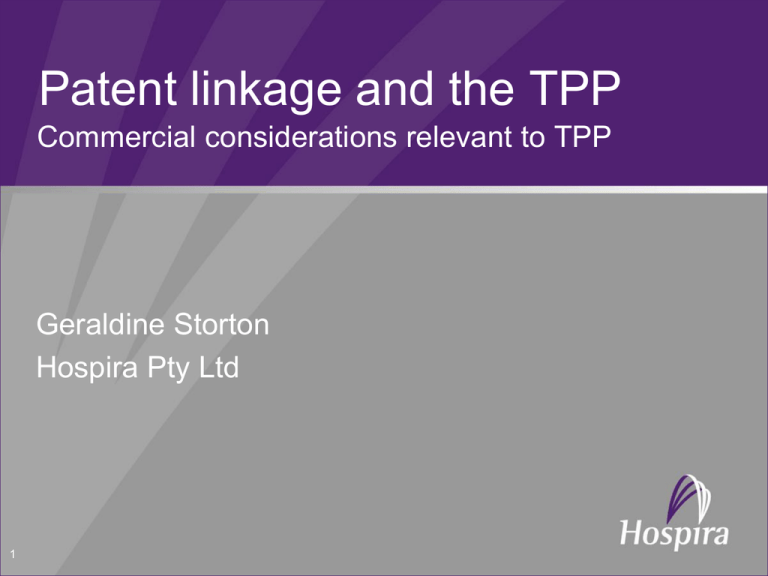
Patent linkage and the TPP Commercial considerations relevant to TPP Geraldine Storton Hospira Pty Ltd 1 Overview • • • • • • • 2 Who is Hospira? What is patent linkage? Relative market sizes of TPP members Patent linkage hypothetical financial analysis Implications of patent linkage hypothetical for Hospira Discussion Conclusions © Hospira, Inc. 2012 Our company Improving the safety, cost and productivity of patient care • World's Leading Provider of Injectable Drugs and Infusion Technologies • Market leadership positions in: – Generic injectable pharmaceuticals globally – Biosimilars in Europe and Australia – Medication management systems globally • Distinguished 70-year history – – – – – – Pioneer in innovation and safety Publicly traded since 2004 ~$4 billion in annual revenues Large, growing global markets ~15,000 employees, 13 manufacturing facilities Headquartered in Lake Forest, Ill., USA © Hospira, Inc. 2012 3 Patent linkage and the TPP – what is patent linkage? 4 • US FTAs - trend is to include “patent linkage” provisions requiring patent linkage • Patent linkage makes regulatory approval dependant on the domestic patent position • Patent linkage has been implemented in the US, CA and SG with the following features – Compulsory generic notification if intent to market pre patent expiry – Compulsory stay on regulatory approval if generic sued – Stay is a very effective motivation to sue (equates to compulsory litigation spend) – US only provides generic market exclusivity • US New Trade Policy 2007 proposes no inclusion of patent linkage in FTAs • Patent linkage in ex-US TPP countries will be detrimental to a generic manufacturer’s ability to bring affordable, high quality generics to market. © Hospira, Inc. 2012 Patent linkage works when the market size is large, and the pay-off from a single molecule is significant Source: Business Monitor International, IMS Health Compared to other countries in the TPP group, the annual market value for pharmaceuticals in the US is significantly higher. 5 *Note no data available for Brunei © Hospira, Inc. 2012 Patent linkage - toward a hypothetical model • HSP developed a hypothetical model to determine the impact of patent linkage on generics industries in TPP members • Goal – to determine the commercial return on “litigation” investment (if any) bearing in mind: • • • • • • • 6 Litigation costs Market value of a product at patent expiry Market share obtained Degree of price discounting Profit margin Probability of success in litigation Any “generic exclusivity” on offer © Hospira, Inc. 2012 Commercial implications of Patent Linkage Hypothetical – Results The current GMiA estimated typical cost of litigation in Australia is $5M*. Using typical industry ranges for market size, development cost, market share, price erosion and margins a financial model was created. This model did not return a positive profit for the generic manufacturer unless the cost of litigation was low, or the exclusivity period was long. Duration of exclusivity (yrs) 0.5 1 1.5 Cost to litigate (USD M's) 2 1 0.3 1.6 2.9 4.3 2.5 5 -1.2 -3.7 0.1 -2.4 1.4 -1.1 2.8 0.3 Green shading signifies a positive pay-off (i.e. The pay-off, including the cost of litigating, returns a profit for the generic manufacturer) A threshold value was determined to understand the market value of a drug required to provide a positive return at USD 5M litigation cost and 0.5 years Exclusivity. For the base case this was >USD 200M. There are no injectable products* in Australia selling in excess of $200 M pa. 7 Source: Mean litigation cost estimates provided by GMiA. IMS data for number of molecules selling over $200 M pa © Hospira, Inc. 2012 Commercial implications of Patent Linkage Hypothetical – sensitivity analysis For the base case USD 50M product, we varied the input parameters across plausible ranges to understand the sensitivity of the model. We found that with higher value inputs, a negative return is still expected at Current litigation costs and 6 months exclusivity (as the US has). B) Lower estimate 0.5 Cost to litigate (USD M's) Duration of exclusivity 1 1.5 2 1 -0.9 -0.7 -0.6 -0.4 2.5 5 -2.4 -4.9 -2.2 -4.7 -2.1 -4.6 -1.9 -4.4 C) Upper estimate 0.5 Cost to litigate (USD M's) Duration of exclusivity 1 1.5 2 1 3.6 8.2 12.9 17.5 2.5 5 2.1 -0.4 6.7 4.2 11.4 8.9 16.0 13.5 There are only 13 injectable products* in Australia selling in excess of $50 M pa. 8 *Source: Legal Fee estimates from GMiA. IMS data for number of molecules selling over $50 M pa © Hospira, Inc. 2012 Patent Linkage – Implications for Hospira • Hospira conducted a hypothetical analysis of all of its actual launched products in ex-US TPP countries in the last 4 years. • Under a patent linkage system with compulsory litigation and generic exclusivity, none of the products launched in the last 4 years would have had positive financial return associated them. 9 © Hospira, Inc. 2012 Patent linkage will not work in any country other than the US • Patent linkage works in the US only because of the size of the US market – The size of the prize is incomparable – The US is 50% of WW pharma market & totally eclipses ROW pharma markets • Patent linkage will be very problematic for every other TPP member, including Australia – The relative size of the market is significantly smaller – Compulsory patent litigation is cost prohibitive – Generic market entry will be delayed or eliminated 10 © Hospira, Inc. 2012 Patent linkage will not work in any country other than the US • This generic entry delay (due to patent linkage) will cripple government spending on pharmaceuticals because it will: – Deny the public timely access to cost effective medicines – Inflate health care costs – Be detrimental to government’s ability to manage spending on pharmaceuticals 11 © Hospira, Inc. 2012 Conclusion • Patent linkage in ex-US TPP countries will be detrimental to a generic manufacturer’s ability to bring affordable, high quality generics to market. • The effect of patent linkage will be inequality in health care: – patent linkage will not affect access to affordable medicines in the US, the US public will continue to have access to these medicines, whilst the people of other TPP members will not. 12 © Hospira, Inc. 2012 Thank you Geraldine Storton Hospira Pty Ltd 13


